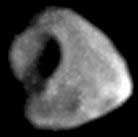|
|
Thebe

Image of Thebe taken by the Galileo
spacecraft on January 4, 2000.
|
| Discovery |
| Discovered by |
Stephen P. Synnott / Voyager 1 |
| Discovered on |
March 5, 1979 |
| Orbital characteristics |
| Mean radius |
221,900 km (0.001483 AU) |
| Periastron |
218,000 km (0.00146 AU) |
| Apastron |
226,000 km (0.00151 AU) |
| Eccentricity |
0.0177 |
| Revolution period |
0.6745 d (16 h 11.3 min) |
| Orbital circumference |
1,394,000 km (0.009 AU) |
| Orbital velocity |
max: 24.352 km/s
mean: 23.923 km/s
min: 23.505 km/s |
| Inclination |
3.12° (to the ecliptic)
0.90° (to Jupiter's equator) |
| Is a satellite of |
Jupiter |
| Physical characteristics |
| Mean diameter |
96 km (110×90 km) |
| Surface area |
33,500 km2 |
| Volume |
~470,000 km3 |
| Mass |
1.5×1018 kg |
| Mean density |
3.0 g/cm3 |
| Surface gravity |
0.0041 m/s2 (0.004 g) |
| Escape velocity |
0.0064 km/s |
| Rotation period |
synchronous |
Equatorial
rotation velocity |
21 km/h |
| Axial tilt |
zero |
| Albedo |
0.047 |
| Surface temp. |
|
| Atmospheric pressure |
0 kPa |
Thebe (thee'-bee, IPA /'θi:bi:/; Greek Θήβη) is the fourth of Jupiter's known moons by distance from the planet. It was discovered by Voyager 1 on March 5, 1979 and was first given the temporary name S/1979 J 2. Later, it was found on images dating back to February 27, 1979. In 1983 it was officially named after the mythological nymph Thebe who was the daughter of the river god Asopus. It is also designated Jupiter XIV.
It is the outermost of the inner Jovian moons.
There appear to be at least three or four very large Theban impact craters (very large in the sense that each of these craters is roughly comparable in size to the radius of Thebe). Little else is known about this moon.
Links
Images of Thebe
... | Amalthea | Thebe | Io | ...
Jupiter's natural satellites
Inner satellites | Galilean moons: Io, Europa, Ganymede, and Callisto | Themisto | Himalia group | Carpo | S/2003 J 12 | Ananke group | Carme group | Pasiphaë group | S/2003 J 2
Retrieved from "http://en.wikipedia.org/"
|
Ancient Greece
|
Medieval Greece
|
Modern Greece
|
|
Science, Technology , Medicine , Warfare
, Biographies , Life , Cities/Places/Maps , Arts , Literature , Philosophy ,Olympics, Mythology , History
|
Science, Technology, Arts
, Warfare , Literature, Biographies
History
|
Cities, Islands, Regions, Fauna/Flora ,
Biographies , History , Warfare
Science/Technology, Literature, Music , Arts , Film/Actors , Sport , Fashion
|
|
|
